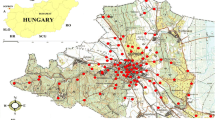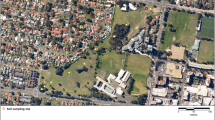Abstract
During our investigation, we analyzed the urban soils from stream banks and sediment of Rák Creek in the area of Sopron, Hungary. The aim of this work was the determination of the anthropogenic influence on a given stream that flows through an urban area (in this case through the city). The assumption was that the streamflow becomes increasingly polluted with toxic elements as it passes through Sopron; we tried to determine the extent to which the stream is polluted. We had 72 urban soil samples at 36 points at 0–10 and 10–20 cm depths on 6 sub-catchments for analyzing the background pollution of Rák Creek. In addition, 6 soil samples from the bank and 12 sediment average samples were taken from the dead region and from the thalweg as well. We analyzed the physical and chemical parameters as well as the heavy metals (e.g., Cd, Co, Cu, Pb, Zn and Ni) in all of the samples. Two element fractions, the total (HNO3+H2O2-extractable) and the available (NH4-acetate+EDTA-extractable) were used for element determination. Toxic elements were measured by ICP-OES in the urban soils and the sediments as well. Urban soils of sub-catchments confirmed the following tendency. On the investigated creek points, the Co and Ni values were below the natural background limits (Cototal 4.90–14.53 mg kg−1, Coavailable 0.64–3.12 mg kg−1; Nitotal 10.77–24.61 mg kg−1, Niavailable 0.75–3.21 mg kg−1). Cutotal content was low except in the case of GYORI point. Pbtotal were under the pollution limit, but Pbavailable were higher than the suggested pollution limit (>25 mg kg−1) in the sediment of thalweg and in the soil of the creek bank at the GYORI site. Summarized, GYORI point was the most polluted; this is also confirmed by the enrichment factor (EF). EF for Pb and Zn increased as we moved toward the city. Based on the investigated properties, there were significant differences in heavy metals between the urbanized and non-urbanized areas. The concentrations of heavy metals were higher in the dead region than in the thalweg except for the GYORI samples. According to our results, the city affects the stream and its influence appears in the values: as soon as the stream reaches the city, most of results increase. Therefore, the degree of heavy metal contamination depends mainly on land use.






Similar content being viewed by others
References
Joint Decree No. 10/2000. (VI. 2) KöM-EüM-FVM-KHVM of the Ministers of Environmental Protection, Public Health, Agriculture and Regional Development, and of Traffic, Communication and Water Management on the Limit Values Necessary to Protect the Quality of Groundwater and the Geological Medium (in Hungarian)
Joint Decree No. 6/2009. (IV. 14) KvVM-EüM-FVM of the Ministers of Environmental Protection and Water Management, Public Health, Agriculture and Regional Development on the Limit Values Necessary to Protect the Quality of Geological Medium and the Groundwater and on Measurement of Pollution (in Hungarian)
Albert L, Jancsó T (2012) Complex study of the urban eco-environment in the Western Transdanubia Region. In: Neményi M, Heil B (eds) The impact of urbanization, industrial, agricultural and forest technologies on the natural environment. Publishing House of National Textbook, Budapest, pp 119–128
Alloway BJ (2012) Soil processes and the behaviour of heavy metals. In: Alloway BJ (ed) Heavy metals in soils: trace metals and metalloids in soils and their bioavailability. Springer, Glasgow, pp 11–37
Barna S (2008) Development of a rapid biotest adaptable to plants to characterize heavy metal contents of soils. Dissertation. Szent István University (in Hungarian)
Baudo R, Giesy JP, Muntau H (1990) Sediments: chemistry and toxicity of in-place pollutions. Lewis Publishers, Michigan
Bretzel F, Calderisi M (2006) Metal contamination in urban soils of Coastal Tuscany (Italy). Environ Monit Assess 118:319–335
Bryan GW, Langston WJ (1992) Bioavailability, accumulation and effects of heavy metals in sediment with special reference to United Kingdom estuaries: a review. Environ Pollut 76:89–131
Cevik F, Göksu M-Z, Derici O-B, Findik O (2009) An assessment of metal pollution in surface sediments of Seyhan dam by using enrichment factor, geoaccumulation index and statistical analyses. Environ Monit Assess 152:309–317
Charzyński P, Bednarek R, Greinert A, Hulisz P, Uzarowicz Ł (2013) Classification of technogenic soils according to WRB system in the light of Polish experiences. Soil Sci Ann 64:145–150
Chen C-W, Kao C-M, Chen C-F, Dong C-D (2007) Distribution and accumulation of heavy metals in the sediments of Kaohsiung Harbor, Taiwan. Chemosphere 66(8):1431–1440
Cuypers A, Remans T, Weyers N, Colpaert J, Vangronsveld J (2012) Soil-plant relationships of heavy metals and metalloids. In: Alloway BJ (ed) Heavy metals in soils: trace metals and metalloids in soils and their bioavailability. Springer, Glasgow, pp 161–194
Dickinson WW, Dunbar GB, McLeod H (1996) Heavy metal history from cores in Wellington Harbour, New Zealand. Environ Geol 27:59–69
Dövényi Z (ed) (2010) Hungarian microregions. Hungarian Academy of Sciences, Budapest (in Hungarian)
Dövényi Z (ed) (2012) Geography of the Carpathian-Basin. Publishing house of Academy, Budapest (in Hungarian)
Fatoki OS, Mathabatha S (2001) An assessment of heavy metal pollution in the East London and Port Elizabeth harbours. Water SA 27:233–240
Fiedler HJ (1990) Bodennutzung und Bodenschutz. VEB Gustav Fischer Verlag, Jena
Gordon N, Mcmahon T, Finlayson P, Gippel C, Nathan N (2004) Stream hydrology: an introduction for ecologists, 2nd edn. Wiley, Chichester
Gribovszki Z, Kalicz P, Csáfordi P, Sermaul K, Szita R (2012) The water status change of a small stream system due to urbanization. In: Neményi M, Heil B, Kovács AJ, Facskó F (eds) The impact of urbanization, industrial, agricultural and forest technologies on the natural environment. Publishing House of National Textbook, Budapest, pp 161–170
Horowitz AJ (1985) A primer on trace metal—sediment chemistry. United States Government Printing Office, Alexandria
Horváth A, Szűcs P, Bidló A (2015) Soil condition and pollution in urban soils: evaluation of the soil quality in a Hungarian town. J Soils Sediments 15(8):1825–1835
IUSS Working Group WRB (2007) World reference base for soil resources 2006. 1st update 2007. World Soil Resources Reports No. 103. FAO, Rome
Kabata-Pendias A, Pendias H (2001) Trace elements in soils and plants, 3rd edn. CRC Press, Boca Raton
Kádár I (1998) Remediation handbook 2. Investigation of contaminated soils. Ministry of Environment, Budapest (in Hungarian)
Kaushik A, Kansal A, Santosh Meena, Kumari S, Kaushik C-P (2009) Heavy metal contamination of river Yamuna, Haryana, India: assessment by metal enrichment factor of the sediments. J Hazard Mater 164:265–270
Kovács M, Nyári I (1984) The heavy metal contents of the public places of Budapest. Agrochem Soil Sci 33(3–4):501–510 (in Hungarian)
Luoma SN, Davis JA (1983) Requirements for modeling trace metal partitioning in oxidized estuarine sediments. Marine Chem 12:159–181
Manta DS, Angelone M, Bellanca A, Neri R, Sprovieri M (2002) Heavy metals in urban soils: a case study from the city of Palermo (Sicily), Italy. Sci Total Environ 300:229–243
McCready S, Birch GF, Long ER (2006) Metallic and organic contaminants in sediments of Sydney Harbour, Australia and vicinity—a chemical dataset for evaluating sediment quality guidelines. Environ Int 32:455–465
Morel JL, Heinrich AB (2008) SUITMA—soils in urban, industrial, traffic, mining and military areas; an interdisciplinary working group of the ‘International Union of Soil Science’ (IUSS) dedicated J Soils Sediments to soils strongly modified by human activities. J Soils Sediments 8:206–207
Morel JL, Charzyński P, Shaw RK, Zhang G (2015) The seventh SUITMA conference held in Toruń, Poland. J Soils Sediments 15:1657–1658
MSZ 21470–50 (2006) Environmental testing of soils. Determination of total and soluble toxic element, heavy metal and chromium(VI) content, Hungarian Standard Association, Budapest (in Hungarian)
MSZ-08-0205 (1978) Determination of physical and hydrophysical properties of soils. Hungarian Standard Association, Budapest (in Hungarian)
Müller HW, Schwaighofer B, Kalman W (1994) Heavy metal contents in river sediments. Water Soil Air Pollut 72:191–203
Ódor L, Horváth I (2003) Element distribution and environmental conditions in geochemical map**. In: Gy Pantó (ed) Material flows and their impact on nature. Hungarian Academy of Sciences, Budapest, pp 151–188 (in Hungarian)
Orbay L (1990) Multivariate regression funds and economic use of wood. Manuscript. University for Forestry and Wood Sciences, Sopron (in Hungarian)
Pickering WF (1986) Metal ion speciation—soils and sediments (a review). Ore Geol Rev 1:83–146
Poulton DJ, Morris WA, Coakley JP (1996) Zonation of contaminated bottom sediments in Hamilton Harbour as defined by statistical classification techniques. Water Qual Res J Canada 31:505–528
Puskás I, Farsang A (2009) Diagnostic indicators for characterizing urban soils of Szeged, Hungary. Geoderma 148(3–4):267–281
Rauret G (1998) Extraction procedures for the determination of heavy metals in contained soil and sediment. Talanta 46:449–455
Rékási M, Filep T (2012) Fractions and background concentrations of potentially toxic elements in Hungarian surface soils. Environ Monit Assess 184:7461–7471
Sándor G, Szabó G (2014) Influence of human activities on the soils of Debrecen, Hungary. Soil Sci Annu 65(1):2–9
Scönlaub HP (ed) (2000) Geology of Austrian provinces—Burgenland. Geologische Bundesanstalt, Wien (in German)
Soares HMVM, Boaventura RAR, Machado AASC, Esteves da Silva JCG (1999) Sediments as monitors of heavy metal contamination in the Ave river basin (Portugal): multivariate analysis of data. Environ Pollut 105:311–323
Stefanovits P, Gy Filep, Gy Füleky (1999) Soil Sciences. Publishing House of Agriculture, Budapest (in Hungarian)
Szabó G, Elek Z, Sz Szabó (2008) Study of heavy metals in the soil-plant system. Cereal Res Commun 36(1):403–406
Szegedi S (1999) The heavy metal pollution of the soil in Debrecen. Hung Sci 106/66(10):1192–1200 (in Hungarian)
Szolnoki Z, Farsang A, Puskás I (2013) Cumulative impacts of human activities on urban garden soils: origin and accumulation of metals. Environ Pollut 177:106–115
Tack FMG (2010) Trace elements: general soil chemistry, principles and processes. In: Hooda PS (ed) Trace elements in soils. Wiley, Chichester, pp 9–38
Taylor SR (1964) Abundance of chemical elements in the continental crust: a new table. Geochim Cosmochim Acta 28:1273–1285
Van Reeuwijk LP (ed) (2002) Procedures for soil analysis (6th ed.). Technical Paper 9. Wageningen
Varga G, Konkoly-Gyúró É, Kovács G, Schmidt G, Radó D, Baranyi K, Czimber K, Boros G, Héjj B, Krassay L, Rácz I, Szemerédy M, Varga T (1999) Information system describing the condition of urban trees and forests. Urban Green Landsc Archit Koppenhaga, 23–25 June 1999
Zöttl HW (1987) Responses of forest decline to experimental fertilization. In: Hutchinson TC, Meema KM (eds) Effects of atmospheric pollutants on forests, wetlands and agricultural ecosystems. Springer Series G: Ecol Sci 16:255–265
Acknowledgments
This research is supported by TÁMOP 4.2.1.B-09/1/KONV-2010-0006 and the “Agroclimate.2” (VKSZ_12-1-2013-0034) EU joint national funded research projects.
Author information
Authors and Affiliations
Corresponding author
Rights and permissions
About this article
Cite this article
Horváth, A., Szita, R., Bidló, A. et al. Changes in soil and sediment properties due the impact of the urban environment. Environ Earth Sci 75, 1211 (2016). https://doi.org/10.1007/s12665-016-6012-8
Received:
Accepted:
Published:
DOI: https://doi.org/10.1007/s12665-016-6012-8




